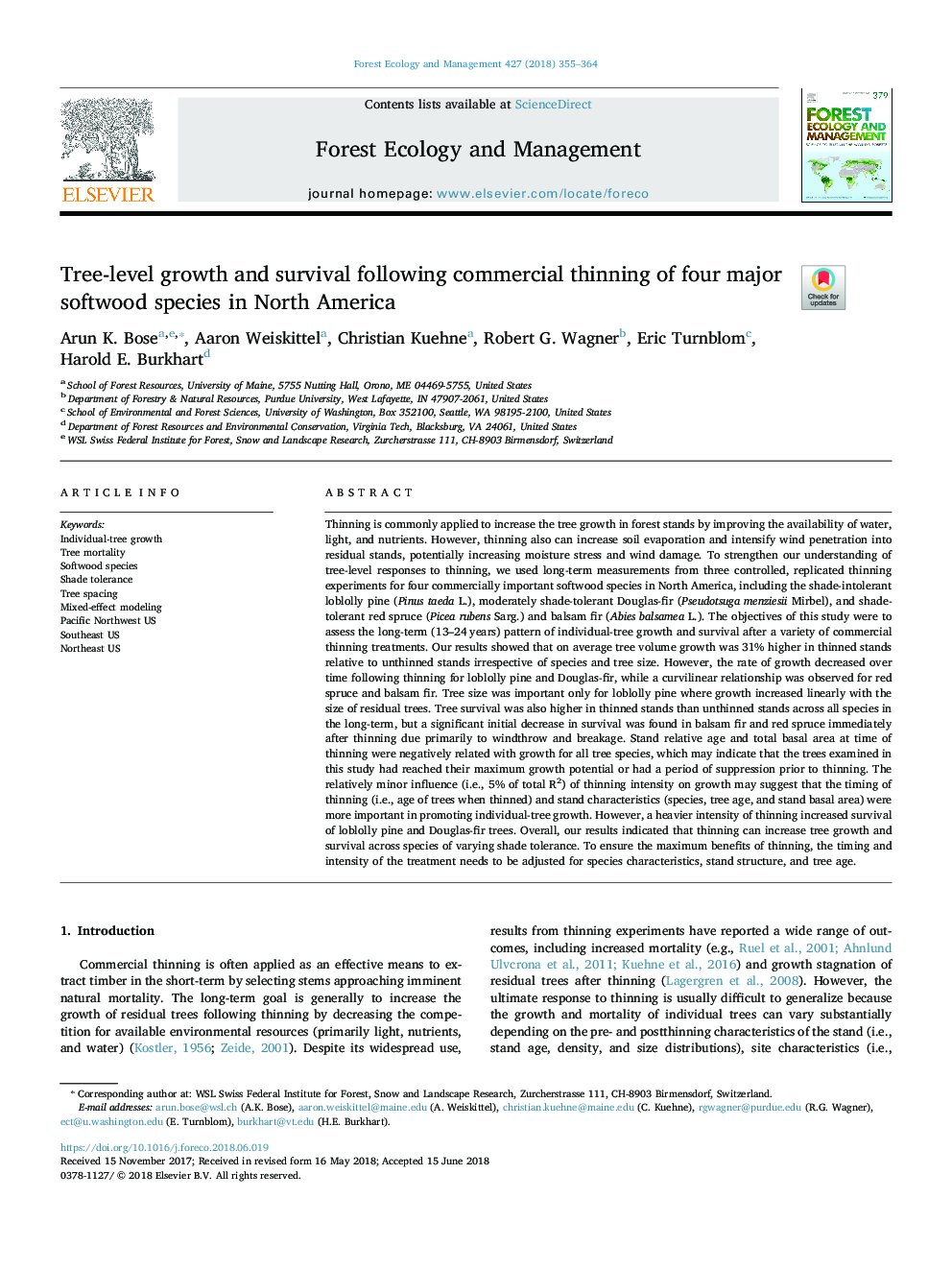| کد مقاله | کد نشریه | سال انتشار | مقاله انگلیسی | نسخه تمام متن |
|---|---|---|---|---|
| 6541525 | 1421333 | 2018 | 10 صفحه PDF | دانلود رایگان |
عنوان انگلیسی مقاله ISI
Tree-level growth and survival following commercial thinning of four major softwood species in North America
ترجمه فارسی عنوان
رشد و زنده ماندن درختان پس از ریزش تجاری از چهار گونه عمده چوب نرم در شمال امریکا
دانلود مقاله + سفارش ترجمه
دانلود مقاله ISI انگلیسی
رایگان برای ایرانیان
کلمات کلیدی
رشد فردی درخت، مرگ و میر درخت، گونه های چوب نرم تحمل سایه فاصله درخت، مدل سازی مخلوط، اقیانوس آرام شمال غربی ایالات متحده، جنوب شرقی ایالات متحده، شمال شرقی ایالات متحده،
موضوعات مرتبط
علوم زیستی و بیوفناوری
علوم کشاورزی و بیولوژیک
بوم شناسی، تکامل، رفتار و سامانه شناسی
چکیده انگلیسی
Thinning is commonly applied to increase the tree growth in forest stands by improving the availability of water, light, and nutrients. However, thinning also can increase soil evaporation and intensify wind penetration into residual stands, potentially increasing moisture stress and wind damage. To strengthen our understanding of tree-level responses to thinning, we used long-term measurements from three controlled, replicated thinning experiments for four commercially important softwood species in North America, including the shade-intolerant loblolly pine (Pinus taeda L.), moderately shade-tolerant Douglas-fir (Pseudotsuga menziesii Mirbel), and shade-tolerant red spruce (Picea rubens Sarg.) and balsam fir (Abies balsamea L.). The objectives of this study were to assess the long-term (13-24â¯years) pattern of individual-tree growth and survival after a variety of commercial thinning treatments. Our results showed that on average tree volume growth was 31% higher in thinned stands relative to unthinned stands irrespective of species and tree size. However, the rate of growth decreased over time following thinning for loblolly pine and Douglas-fir, while a curvilinear relationship was observed for red spruce and balsam fir. Tree size was important only for loblolly pine where growth increased linearly with the size of residual trees. Tree survival was also higher in thinned stands than unthinned stands across all species in the long-term, but a significant initial decrease in survival was found in balsam fir and red spruce immediately after thinning due primarily to windthrow and breakage. Stand relative age and total basal area at time of thinning were negatively related with growth for all tree species, which may indicate that the trees examined in this study had reached their maximum growth potential or had a period of suppression prior to thinning. The relatively minor influence (i.e., 5% of total R2) of thinning intensity on growth may suggest that the timing of thinning (i.e., age of trees when thinned) and stand characteristics (species, tree age, and stand basal area) were more important in promoting individual-tree growth. However, a heavier intensity of thinning increased survival of loblolly pine and Douglas-fir trees. Overall, our results indicated that thinning can increase tree growth and survival across species of varying shade tolerance. To ensure the maximum benefits of thinning, the timing and intensity of the treatment needs to be adjusted for species characteristics, stand structure, and tree age.
ناشر
Database: Elsevier - ScienceDirect (ساینس دایرکت)
Journal: Forest Ecology and Management - Volume 427, 1 November 2018, Pages 355-364
Journal: Forest Ecology and Management - Volume 427, 1 November 2018, Pages 355-364
نویسندگان
Arun K. Bose, Aaron Weiskittel, Christian Kuehne, Robert G. Wagner, Eric Turnblom, Harold E. Burkhart,
